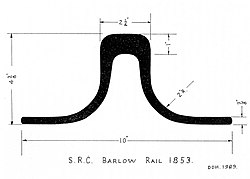Barlow railwas a rolled rail section used on early railways. It has wide flaring feet and was designed to be laid direct on theballast,without requiringsleepers.It was widely adopted on lightly trafficked railways, but was ultimately unsuccessful because of maintenance difficulties.

It resembles thebridge railused for Brunel'sbaulk road,but was of tapering form, rather than with the flat base of the heavier bridge rail intended for laying onto timber.
Usage
editIn the mid-nineteenth century, railway networks were expanding into areas where lighter traffic was expected. The first cost of conventional railway track was considerable, and cheaper alternatives were sought. The Barlow rail offered this benefit, by avoiding the cost of sleepers and chairs altogether. Laid directly in the ballast, it required no other ancillary equipment; however the rail itself was significantly heavier and more expensive than conventional rails.
In practice it had several disadvantages; in particular there was no gauge tie, so that if the ballast was poorly consolidated, the rails could gradually move independently, resulting in a serious derailment risk. Some modifications involved the provision of tie bars between opposing rails to maintain thegauge.
The wider and heavier rail section was considerably stiffer to lateral bending, and this made smooth alignment in curves difficult, especially at the joints.
On curves, passing vehicle wheels generate a crabbing effect, tending to push the rails apart, and in the absence of sleepers this tended to rotate the rails outward, that is, they tended to tip outwards.
Inventor
editThe rail profile was invented in 1849 byW.H.Barlow,engineer of theMidland Railway.The design was patented (12438 of 1849)[1]
On 14 May 1850, he presented a paper to theInstitution of Civil Engineersin London detailing his ideas[2]and stating that a test section of 125 lb/yd [62 kg/m] rail on the Midland Junction Railway had proven satisfactory.
He admitted that there had been difficulty in rolling the section but this had been overcome by the manufacturers atMiddlesbrough.
Application
editThe rail section was adopted byBrunelfor the South Wales Railway[3]
- TheSouth Wales RailwayfromSwanseatoCarmarthen- 1852. Extended towardsMilford Havenin 1854[2]
- New South Wales Railways- 1855 -SydneytoParramatta.[4](Some pieces of this rail are on display at thePowerhouse Museum,SydneywithLocomotive No. 1.)
- Geelong and Melbourne Railway Company- 1855 - one order of 300 tons used in tracks nearGeelong,Victoria.[5]
- Didcot Railway Centre,Oxfordshire
- In Argentina theBuenos Aires Western Railwayin 1857 and theBuenos Aires Great Southern Railwayin 1865
Secondary usage
editBarlow rail was widely withdrawn from primary service as rails and so large quantities of it were available cheaply. The South Wales Railway offered 400 tons of it for sale in 1857, with free delivery to anywhere along their line.[6]
The large extent of Barlow rail laid in the routes influenced by Brunel, and in New South Wales, has left a legacy of fence posts, and in some cases bridge decks:
- South Devon Railway- underbridge[7]
- Conwy Valley Line- underbridge[8]
- Shipton on CherwellHalt - fencepost[9]
- Dorrigo Steam Railway and Museum[10]
- Fairfordbranch - structures[11]
- Clevedon Pierwas constructed from second hand Barlow rail.[12]
- Loughor railway viaductwas rebuilt in 1880 and the new decking was constructed of Barlow rail, laid crosswise.[6]
See also
editReferences
edit- ^Brits at Their Best science timeline
- ^abEngineers of the Sydney Railway Company Part 1 - The Selection of the Rail Type - The Barlow RailHagarty, DonAustralian Railway Historical Society Bulletin,February, 1991 pp43-47
- ^McDermot, E T, History of the Great Western Railway, 1927, published by the Great Western Railway
- ^Gunn, John (1989).Along Parallel Lines: A History of the Railways of New South Wales.Melbourne:Melbourne University Press.p. 62.ISBN0-522-84387-5.
- ^Geelong Advertiser and Intelligencer, Wednesday 5 July 1854, page 4.
- ^abJones, Stephen K. (2006).Brunel in South Wales.Vol. II: Communications and Coal. Tempus. p. 159.ISBN0-7524-3918-9.
- ^"South Devon Railway bridge replacemenr".Archived fromthe originalon 2006-08-19.Retrieved2008-05-18.
- ^The Conwy valley line - Cwm Prysor to Bala Junction
- ^Great Western Railway - Kidlington TO Blenheim & Woodstock[permanent dead link]
- ^List of other exhibits
- ^Lechlade station description
- ^Coombes, Nigel (1995).Striding boldly: The story of Clevedon pier.Clevedon Pier Trust Ltd. p. 14.ISBN978-0952521600.